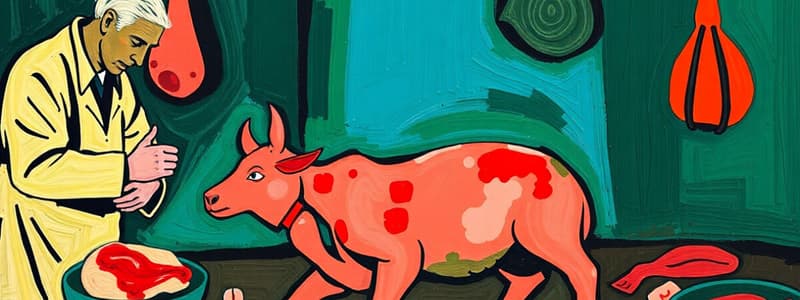Podcast
Questions and Answers
What is the primary purpose of ante mortem inspection?
What is the primary purpose of ante mortem inspection?
- To remove internal organs from animals
- To classify meat for sale
- To ensure animal welfare and health status (correct)
- To eliminate microorganisms from surfaces
What does 'PSE meat' stand for and how is it characterized?
What does 'PSE meat' stand for and how is it characterized?
- Pale, soft, and exudative meat, usually from swine (correct)
- Pumped, smoked, and emulsified meat, often from lamb
- Processed, seasoned, and exquisite meat, typically from beef
- Preserved, salted, and enhanced meat, typically from poultry
Which term refers to carcasses deemed unfit for human consumption?
Which term refers to carcasses deemed unfit for human consumption?
- Passed for Rendering
- Inspected and Passed
- Fit for Human Consumption
- Inspected and Condemned (correct)
What is scalding in the context of animal slaughter?
What is scalding in the context of animal slaughter?
What is the role of a Deputized Meat Control Officer?
What is the role of a Deputized Meat Control Officer?
What does the term 'hot meat' refer to?
What does the term 'hot meat' refer to?
What is the process of evisceration?
What is the process of evisceration?
Which of the following best defines contamination in meat processing?
Which of the following best defines contamination in meat processing?
Flashcards
Abattoir
Abattoir
A registered place for slaughtering animals for human consumption.
Carcass
Carcass
The body of a slaughtered animal after bleeding and dressing.
Ante Mortem Inspection
Ante Mortem Inspection
Inspection of animals before slaughter to check for health and welfare.
Fit for Human Consumption
Fit for Human Consumption
Signup and view all the flashcards
Edible By-Product
Edible By-Product
Signup and view all the flashcards
Stunning
Stunning
Signup and view all the flashcards
Slaughter
Slaughter
Signup and view all the flashcards
Post Abattoir Handling
Post Abattoir Handling
Signup and view all the flashcards
Study Notes
AGSC 50 - Slaughtering of Animals and Processing of Their Products
- Importance of Animal Products: Meat, milk, and eggs are significant sources of income and family consumption, comprising 55% protein and 16% calories (FAO, 1992).
Terminology
- Abattoir: Licensed premises for animal slaughter (human consumption).
- Brand: Approval mark for slaughtered animals.
- Carcass: Body of a slaughtered animal after bleeding and dressing.
- Ante Mortem Inspection: Pre-slaughter inspection for animal health and welfare.
- Boning: Removing bones from meat cuts.
- Bung: Part of the colon in slaughtered animals.
- Contamination: Transmission of undesirable substances to meat.
- Controlling Authority: National Meat Inspection Service (NMIS) which replaced the NMIC.
- Deputized Meat Control Officer: Trained veterinarian authorized for meat inspection.
- Disinfection: Using chemicals to eliminate microorganisms from surfaces.
- Downer: Animal unable to stand, considered suspect for slaughter.
- Edible By-Product: Parts of the animal (not meat) safe for human consumption.
- Emergency Slaughter: Slaughter due to an accident or condition like suffocation.
- Evisceration: Removing the internal organs.
- Fit for Human Consumption: Meat deemed suitable for consumption after inspection and free of disease or contamination.
- Grading: Classifying meat based on characteristics for sale.
- Hot Meat: Meat clandestinely slaughtered and not properly handled.
- Inedible By-Products: Non-consumable materials from slaughter.
- Inspected and Condemned: Carcasses unfit for human consumption.
- Inspected and Passed: Carcasses approved for human consumption.
- Lean Cuts: Pork cuts (loin, ham, shoulder) with less fat.
- NMIS: National Meat Inspection Service.
- Passed for Rendering: Carcasses suitable for animal feed production.
- Post Abattoir Handling: Meat handling after slaughter (transport, storage).
- Primal Cuts: Primary cuts of meat (e.g., loin, ham, shoulder).
- PSE Meat: Pale, soft, and exudative meat (mostly in swine).
- Retained: Carcasses held for further examination.
- Rigor Mortis: Stiffening of muscles after death.
- Scalding: Submerging carcass in hot water (54-82°C).
- Scraping: Removing hairs/feathers after scalding.
- Shrouding: Wrapping carcasses with cloth for preservation.
- Slaughter: Humane killing of food animals.
- Sticking: Bleeding process.
- Stunning: Rendering animals unconscious before slaughter.
- Suspect: Animals with potential disease requiring further inspection.
- Variety Meat: Edible by-products.
Slaughter Requirements
- Cleanliness of meat: Essential for hygiene.
- Hygiene: Important in production.
- Efficient meat inspection: Critical for safety assurance.
- Preservation: Maintaining meat quality.
- Skilled butchers and proper equipment: Essential for efficient slaughter.
Ante-Mortem Inspection
- Age: Specific ages for various animal types, with swine ranging from 6-12 months old.
- Sex: Factors such as barrows/gilts (swine), boars, sows affecting meat quality.
- Size: Different sizes required for cattle/carabao (300-450 kg), and hogs (80-100 kg).
- Fatness: Fat composition influences flavor and juiciness.
- Health: Animals must be healthy.
Post-Mortem Inspection
- Dressing Percentage (approx.): Percentage of edible portion (hog-70%, cattle-60%).
- Classification: Classifying meat based on characteristics.
- Inspection and Condemnation/Passing: Process of inspecting carcasses for quality and fitness for human consumption.
Studying That Suits You
Use AI to generate personalized quizzes and flashcards to suit your learning preferences.




